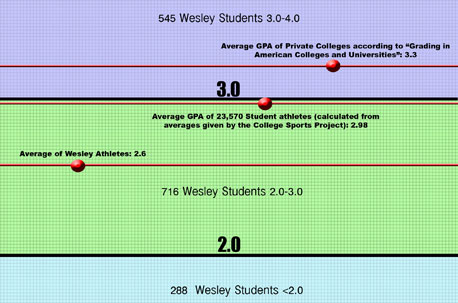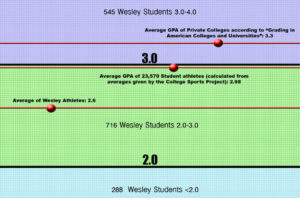By Kim Manahan (Whetstone Staff Writer)
A recent study reveals that Wesley College’s school-wide grade point average (GPA) may be below the national average for both private and public colleges.
Although it refused to release the actual average college GPA, Wesley College’s administration said it was happy with the average GPA of its student athletes, a figure released by head coach Mike Drass, despite the fact that this average also went below the national average for student athletes.
The 363 Wesley College student athletes’ average grade point average was 2.64 in the fall, Drass said.
But, according to a study by The College Sports Project, this is below the average of the data submitted by the 80 participating colleges in the College Sports Project produced by Northwestern University. (http://www.collegesportsproject.org/)
The average GPA of the data submitted for 8,951 recruited men athletes is 2.84; for the 6,259 women, it’s 3.18.
The overall average GPA of students at private colleges is a 3.3 and 3.0 for public colleges, according to another study, “Grading in American Colleges and Universities,†where data was sifted from 160 public and private colleges (www.gradeinflation.com/tcr2010grading.pdf).
Patricia Dwyer, vice president of academic of affairs, provided The Whetstone only with GPA percentages.
In the fall, nearly 1 in 5 students earned below a 2.0, she said; almost half scored between a 2.0 and 3.0, and a little more than a third earned above a 3.0.
“I think it’s important for students to get a 3.0,†said sophomore Matthew Tappan, a history major. “That’s what we’re here for.â€
The average for the school should be a 3.3, the Dean’s List mark, he said.
Mary-Alice Ozechoski, dean of students, announced at a recent open house that “our athletes have some of the highest GPAs.â€
Forty percent of student athletes have earned above a 3.0, Drass’ figures showed. That shakes out to about 145 of the 363 student athletes.
“We should all be proud of them,†Ozechoski said.
Thirty-two football players, or about one-third, have earned above a 3.0.
These students were named to the Atlantic Central Football Conference All Academic Team for fall 2010. There are about 100 players listed on Wesley’s football roster.
“It is strictly an academic award,†Drass said. “You don’t have to be a starter to receive this honor.â€
Academics come first for junior Trevor Kling, a member of the junior varsity football team, although other players have said they are majoring in “football†at Wesley.
“Academics come first,†Kling said. “The most difficult thing was balancing time between my two commitments.â€
Kling is a business major with a concentration in marketing. He also is the vice president of Wesley’s College Democrats.
“I put 10 hours a week into school,†he said, “and 12 hours into athletics.â€
Kling transferred to Wesley after attending Harrisburg Area Community College in fall 2009.
The 32 student athletes from Wesley made up about a third of the 112 players from four colleges placed on the ACFC for the fall.
“I think that upperclassmen who play sports or hold an office in a club or organization should be required to hold at least a 2.75,†said junior Megan Bradley, an education major. “In those positions, people could look to you as a role model and you should be helping to lead, and not by setting a mediocre example.â€
Some students find the student-athlete 2.64 average to be low.
Athletes should have at least a 2.75, Bradley said. “They’re a student athlete, not just an athlete.â€
Tappan finds the athletes’ average of 2.64 understandable.
“I understand they’re busy and balancing [athletics] with a full course load,†he said. “There’s always room for improvement. Academics come first.â€
Some students say they’d like to know the average Wesley GPA, not just the athletes’.
“It seems strange that they wouldn’t release it,â€Â Bradley said. “But I guess it does make sense because it could be a sore spot with the college if they are not really happy with where they are right now.â€
An acceptable average would be at least a 2.5, but no lower, she said.
While 292 students made the Dean’s or President’s lists in fall 2010, about 150 were placed on academic probation, and another 80 were academically suspended.
Students who make a 3.3 or higher are put on the Dean’s list, and the 35 who made the President’s list made a 4.0.
The probation and suspension numbers are estimates, said Dr. Angela D’Antonio, a member of the academic standing committee, which decides most probations and suspensions.
“Some students aren’t academically prepared for college,†D’Antonio said.
Dwyer did not release the final probation and suspension numbers.
Freshmen are expected to maintain at least a 1.75 GPA and all other undergraduate students a 2.00.
“The school’s GPA does reflect because if most everyone has low GPAs, people may begin to wonder what exactly is going on,†Bradley said.
There is no school average to compare to the athletes’ average GPA.
“We don’t feel comfortable in comparing student populations,†Dwyer said.
“I don’t think we should share each team individually,†Drass said. “We want to promote the department as a whole.â€
Still, the athletics department released the two highest academic standing teams. Women’s cross-country, which has nine members, averaged a 3.46, and the men’s golf team, which totals seven students, averaged 3.07.






